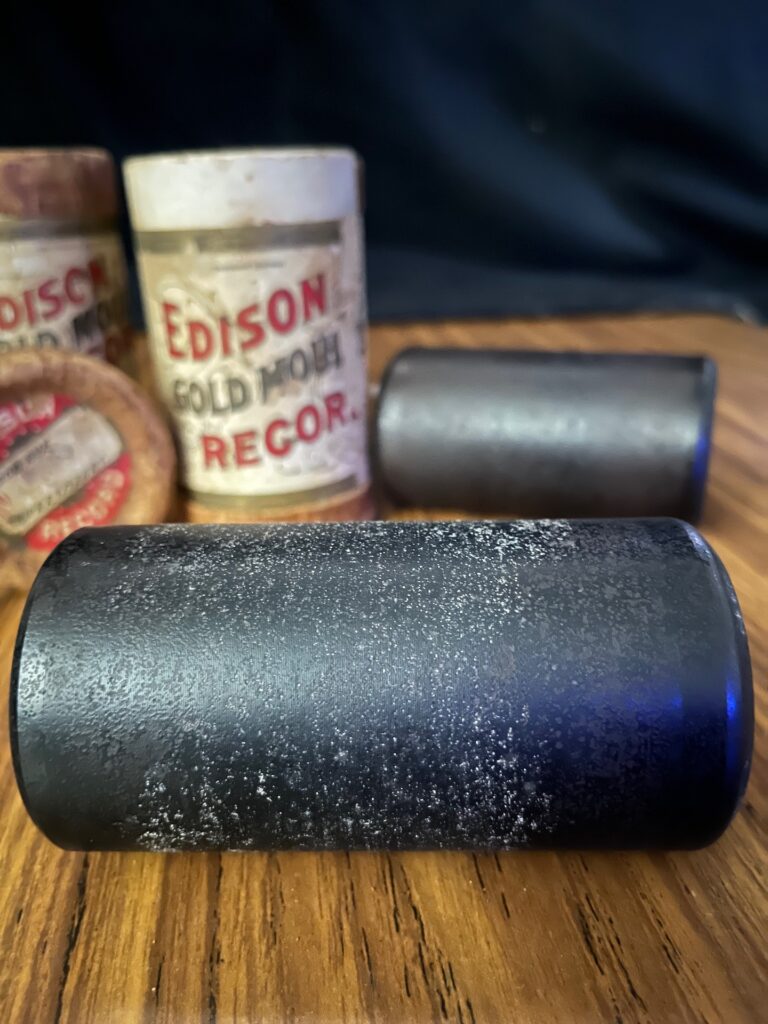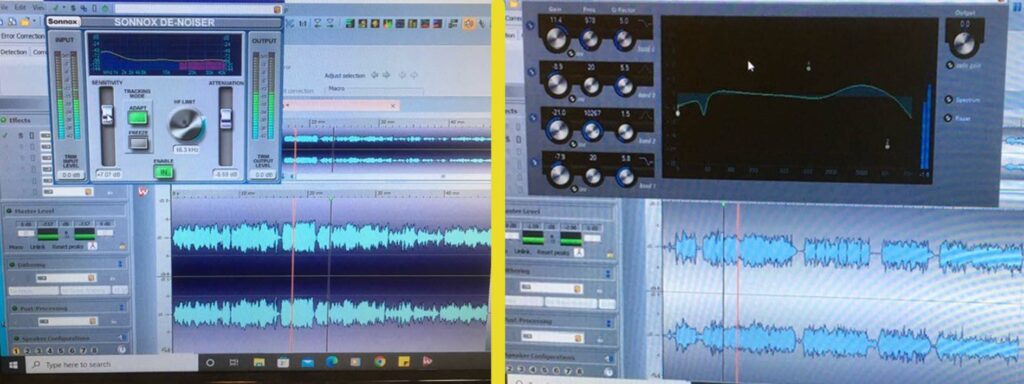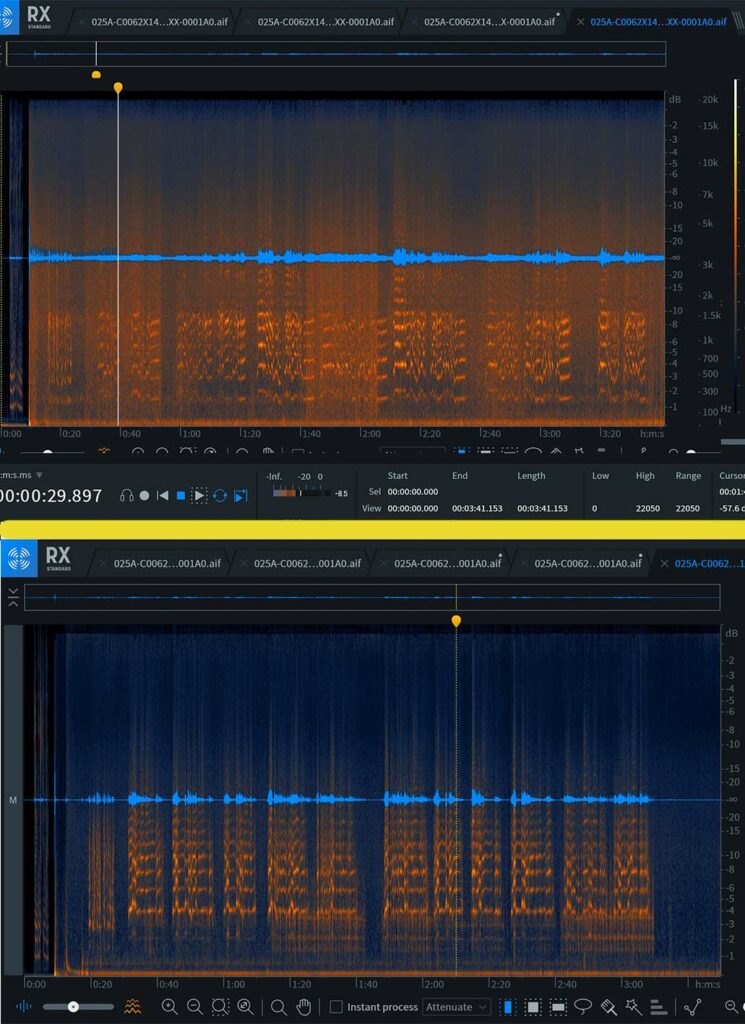PARADISEC audio engineers Jodie Kell and Nick Fowler-Gilmore discuss noise and crud reduction techniques for problematic audio files
PARADISEC has been collaborating with the British Library on True Echoes, a research project that is reconnecting some of the earliest sound recordings of Oceanic culture with originating communities. The recordings are from the British Library Sound Archive which were created using wax cylinder phonographs and they were made in Papua New Guinea, Solomon Islands, Vanuatu, New Caledonia and Australia between 1898 and 1924. As part of the project, the British Library has digitised the recordings and is working with local organisations to connect them with communities.
Wax cylinders are the earliest commercial recording medium. In the 1870’s Thomas Edison developed the phonograph, a machine that could record and reproduce sound by indenting sound vibrations onto a cylinder with a needle. Originally, he used tin foil wrapped around metal, but by 1889, when Edison’s phonograph became commercially available, it used wax cylinders as the recording medium.

One of the main drawbacks of this format are age and wear and tear of the wax cylinders. Some were softer wax which meant they only really designed for a dozen or so plays before they would wear out. Then there was a harder wax version designed for 100+ playbacks. Because these cylinders are so old, even though they have been safely stored in the British Library, the quality has deteriorated over time and the audio contains a lot of noise, as you can hear in this excerpt.
Noise Reduction by PARADISEC Audio Engineers
As part of the process of reconnecting the recordings with community members, PARADISEC audio engineers Jodie Kell and Nick Fowler-Gilmore have been cleaning up the audio to improve listening quality. We will go through the noise reduction process, explain the elements used and share our experiences in working with these recordings.
Nick Fowler-Gilmore used the Sonnox DeNoiser plugin for Wavelab Audio Mastering Software. The DeNoiser focuses on two main parameters: Sensitivity and Attenuation, adjusted using a slider. This regulates a noise detection circuit to detect and minimise noise based on a calculated frequency circuit that finds common noise. Whilst there is a visual, ultimately one must rely on a critical ear to determine the appropriate amount of adjustment to suit desired noise reduction.
For the next step, Nick used a 4 band Equaliser (EQ). With EQ, you can adjust the volume level of a frequency (or range of frequencies) within a sound, which allows you to cure a sound of its imperfections by cutting unwanted frequencies and/or boosting others to balance the sound. In this case, it was used for some high cut (everything above about 15000khz) to reduce high frequency noise and crackle and also low cut (everything below roughly 60khz for those bottom end thumps n bumps) Unlike the Sonnox DeNoiser which has an algorithm which does most of the work, the EQ gives more control over the final adjustments.

Jodie Kell used Izotope RX9 Audio Repair kit with Logic Pro software. RX9 does use plug ins much the same as the Sonnox Denoiser utilised by Nick. Plug ins operate as audio effects within the software. However, the RX9 can also operate as a separate application and this allows for more detailed and nuanced analysis of sound. Jodie used the Spectral Editor as a application module which has a spectogram/waveform display., One advantage she found was that this gives you visual analysis to support audio inspection.
Jodie followed the advice of audio writer and music editor Mike Metlay, in designing her workflow. Metlay uses the phrase ‘mud flows downstream’ in discussing basic principles of thoughtful studio work. This refers to the audio signal flow and the idea that much like mud travels downstream and accumulates in greater and greater amounts, distortion and artifacts, technically known as “crud”, will build up as you go. For this reason, the order of operations in noise reduction can play a role in how successful you are in cleaning and de-noising.
This is the workflow that Jodie used as she followed Metlay’s order of operations. The RX9 gives you a range of tools to deal with each of these steps in the noise reduction process.
- Remove the first and the deepest: clipping.
- Check for stereo Issues, which can include azimuth adjustments.
- Remove clicks and hums
- Removing noise using the Spectral Denoiser
- Finally balancing the sound with the use of EQ

We have shared two processes for dealing with problematic audio files such as the True Echoes recordings from the British Library Sound Archives. The tremendous age of the recordings, as well as the unstable wax cylinder recording medium, lead to greatly deteriorated sound quality. We demonstrated how audio plug ins and software can improve the audio quality with two sound excerpts.
Using visual methods such as spectrogram and the algorithms in plug ins contrbute greatly to noise reduction, however, it does ultimately come down to careful and close listening and making choices about how much to change, remove or adjust. It is important to keep in mind that when removing noise or reducing frequencies, you are possibly also removing and reducing the audio that you want. Overuse of any of these plug ins or apps can make the original audio ugly or unlistenable.
Whilst we did find that some of the noise from the original audio files was impossible to remove, and some files were worse than others, we were able to reduce unwanted noise and crud so that listeners could more easily discern the sounds and words to enhance the meaning of the recordings and to improve the listening experience for community members.
You can hear more about the True Echoes project and the sound recordings in the Toksave: Culture Talks podcast episodes 10 and 11.
 Follow
Follow